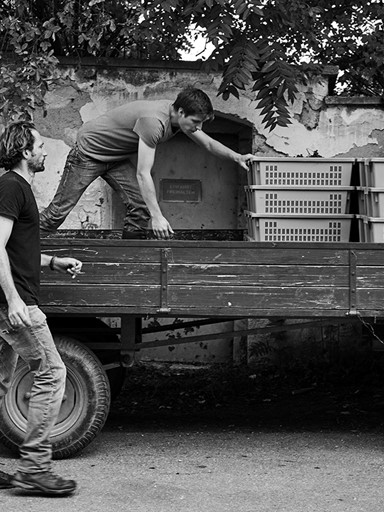
New Arrivals
Gut Oggau, Burgenland, Austria
We caught up with Stephanie and Eduard, live and direct from the vineyards of Oggau, in Burgenland, Austria, on a warm sunny spring day in March...
Staying true to the English stereotype - “how’s the weather?” I ask, the classic English icebreaker!
“Well, it’s dryer and dryer, but with biodynamics, we can adapt well to climate changes. The weather is completely different from what it used to be here, so change has happened, and it is a challenge, but we are lucky to work with deeply rooted vines that can cope with less water. We see more and more extremes weather-wise, so let’s see what the future will bring. In general terms, agriculture is the key to solving these problems. Sustainable farming can help to bring carbon from the atmosphere back into the soils. So, the more that people work organically and biodynamically, the better it is for the climate, but that requires consumers to play their part also, to consume wisely and sustainably, not just buying the cheapest that they can get.”
From the outset, it is clear that one of Stephanie and Eduard’s primary focuses has always been sustainability; but we also learn that love and energy play equal parts, and in so doing, they have created a family of incredible wines.
“The thing with our wines is that we can’t differentiate because we love all of them. Each one perfectly encapsulates their profile. We put the same love, energy and passion into each of the vineyards. There’s no special feeling towards one or the other. Every new vintage is a step towards sharpening their profiles, another year of working biodynamically, another year of strengthening the plant, vitalising the soil, so it’s very exciting storytelling for each of the wines.”
View Wines
So what can you tell us about the 2020 vintage?
It’s been an amazing vintage for us - we’re really excited about the quality that we have in the barrel. We had an early budburst at the beginning of April and no late frost, and then May and June gave us regular rainfall during the flowering period, which isn’t common anymore. So, there was a good supply of water. The yield has been reduced a little, and the plants appreciated the rain. Towards the end of the season in August and September, we had really nice weather, which gave us perfect picking conditions, and we had surprisingly cold nights in August, which has preserved great fresh fruit flavours in the wines, so we’re really happy! They have an excellent structure, and they’re very lively wines!
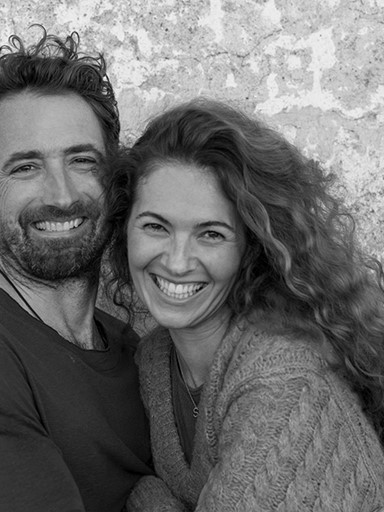
“The wines are intrinsically linked to a time and a place. Cumulative energy-focused strength and collective finesse. The spirit of youth and the wisdom of maturity united. With every sip, the whole year unfolds on your palate.”
Fourteen years have passed since you started Gut Oggau - how did you get to where you are today?
It was tough when we started, the wine style wasn’t that popular, and nobody really understood the faces on the labels - we were really struggling for the first couple of years, especially here in Austria, because people had different expectations than what we had for our wines, so we needed to find crazy people abroad, and it was Fred who was one of our first export partners - he was one of the first to trust us, he saw the potential, so that’s why the UK has always been one of the major markets for us and from an emotional perspective it will always be. When we first started, we would go door to door, with a trolly full of samples, with Fred introducing the wines to different restaurants. That was really good groundwork and also for the cause of biodynamics… it was certainly a special time. Today, it seems like a fairy tale, but it was very different when we first started, which helps us keep our feet on the ground.
What is new at Gut Oggau today?
For the past year, we’ve been working with horses - which has had a big impact on us - it positively brings us out of our comfort zone in many ways. Neither of us worked with horses before, although Stephanie used to ride when she was a kid. One of the guys in our team is experienced with looking after horses, so it’s great to learn from him - we’ve started training the horses to work in the vineyards, and it’s quite an adventure, a very, very nice one. It has given such a push to our team, the vineyards, and everything around us.
You can really feel the plants cheering as you walk through the vineyards in a deep energetic way. It’s crazy; you get goosebumps when you feel this. The introduction of horses has brought a very positive effect on the estate for all of us.
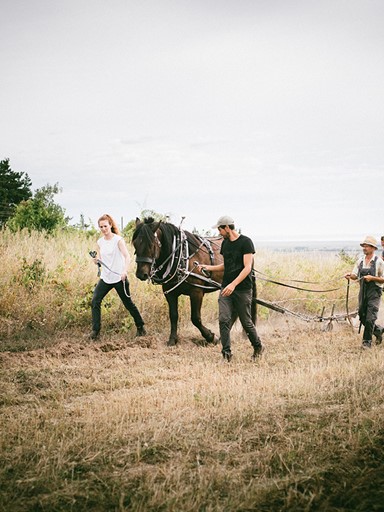
You have bottled three field blends, a white, a red, and a rosé, in 1 litre bottles under the name of ‘Maskerade,’ what can you tell us about these wines?
These wines come from vineyards that we started working with in 2018 and after. They surround the village of Oggau, so the terroir is very similar to our existing sites. The vineyards are in biodynamic conversion, and as it takes three years for conversion to take place - we thought it would be best to give the vineyards the time to adapt and give us time to get familiar with the vineyard. It was obvious that they would not show their true potential in the first, second or third year, so we decided to bottle them separately as they are masquerading their true character, which is why the faces on the labels are wearing masks. But in the longer-term, once the vineyards are certified, they will either be integrated into the existing wine family or become new members depending on the profiles of the vineyards. So, if you didn’t get the chance to taste the Maskerade wines - now is your chance because this vintage might be the last one!
Where did the idea to create the story for the labels come from?
For our first vintage, we didn’t have any experience with the natural wine approach but also, we didn’t know what the vineyards would be like in terms of storytelling. The previous owners used to sell grapes rather than make wines in their late years, so there was no reference point in terms of quality or reference to the expression of the soil. So that’s how we came to take on the natural approach because it was really important not to change the vineyards or treat the wines but to discover their natural potential.
We didn’t follow a style of wine; it was for us to find a reference point in the vineyards. We decided to blend parcels that had a similar terroir and it was really astonishing how particular in personality and characterful the wines tasted [during fermentation and afterwards] even in the first vintage.
We could feel these personalities in the barrels, so we decided to describe the wines as if they were people.
We wanted to approach the wines in a very emotional and personal way, so we created faces according to their profiles. There is no reference to any living person - the faces symbolise the characters of the wines. For us it’s really important that we don’t judge the wines, this is why we came up with the wine family to make a point that we don’t judge - we wouldn’t say that the younger generation is good, the parents better and grandparent the best - it’s just the different natural potential, showing different personalities. You might have a personal preference, which is fair enough, but you can’t say that one is better than the other. Just different.
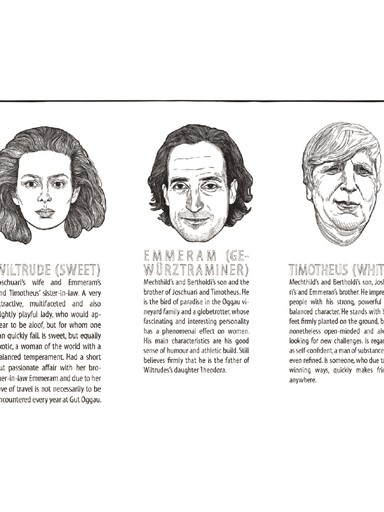
Why does the terroir matter more than the grape varietal?
We took over vineyards that had been planted many years ago, so they’re vines with some age, which meant that we didn’t question the varietals. Instead, we focus on the soil and the expression of the terroir. The varietals we have taken for granted, but our idea was never to produce wines following a certain grape varietal driven style. Most of the vineyards were planted in the ’60s and ’70s, at a time when there was a focus on the Austrian grape varietals - both the climate and the soil suit them well.
But on the other hand, we sometimes feel that specifically looking at the varietal in the expression of the wine can be a little overrated. We don’t agree that a specific grape variety should have a specific taste because it depends so much on the terroir. For example, Blaufränkisch can taste completely different in different parts of Austria. This is why, for us, the terroir matters more than the grape varietal.
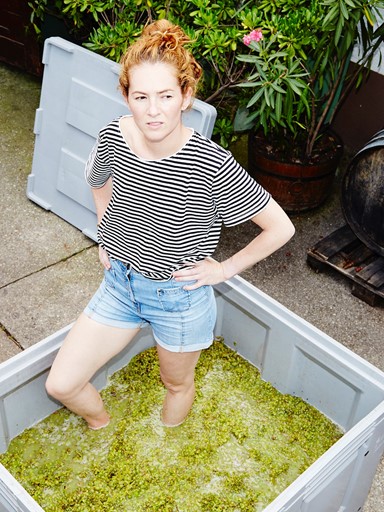
How do the different soil types and terroir affect the flavour of the wines?
We are lucky to have hardly any loam soil, its mainly sand, gravel, limestone, slate, which are mineral, expressive soils, they keep the wines expressive - not too full-bodied or too rich - we are really happy to have these vines on this kind of terroir.
There are different expressions within this terroir, of course: Our gravel soil always brings a youthful and extroverted personality which is where the young generation is planted. On the hillsides, there is limestone - which is very particular, very vibrant, with lots of energy and a crispy freshness which comes from the minerality, not acidity. Slate gives lots of expression but at the same time a composure and a calmness. Topography also makes a difference. The vineyards on the hillsides give a different texture to the grapes found on the flat land. We have a mix of all of those terroirs and topographies, which is really exciting for us. The Parents & Grandparents are planted on the hillside and have different exposures. The Grandparents are planted on a plateau at the top of the hillside. The grapes and the wines feel like more experienced characters - a little more settled. That’s the feeling that we get from that place.
What is the one thing that you want people who drink your wines to know?
Open your minds, feel the wines rather than analyse and take them apart. Approach the wines in terms of harmony and in terms of emotion, what do the wines make you feel? Does it make you feel good, does it lift you up?
What is your ultimate food and wine pairing?
Food that is prepared and grown with love and spirit. It takes energy and love.
What is your biggest inspiration?
Life!
